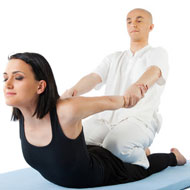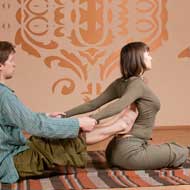Thai Yoga Massage Training
Thai yoga massage, or as it is generically known as a Thai massage, is a form of physical massage that emphasises on deep and repetitive massage techniques. This massage technique has a base in ancient medicinal practices of South-East Asia including India, China and Thailand.
Other names for Thai yoga massage include Nuad Phaen Thai, Nuat Phaen Boran, Traditional Thai Medicinal Massage, and even Thai Classical Massage.
The Thai Yoga massage is supposed to be founded by Jivaka Baccha, believed to be a high ranking doctor at the Sangha, the ancient order of Buddhist monks in the years that Lord Buddha taught. The origins of the Thai massage technique into India can be traced back to when Buddhism was introduced in India about two thousand years back. The practice of the technique of the Thai massage has been handed down from generation to generation.
The basic premise of a Thai yoga massage is that there are invisible energy lines running along the body. Ten of these lines are usually selected during Thai massage which slowly helps the body and its internal organs to work normally. Some schools claim to teach the original Thai massage but if you have found a school whose massage suits you, you should check whether that school has a course that you can get certified in.
In this massage, you are made to lie on the floor, in loose fitting clothes and trained personnel stretch and push your muscles, to provide relief. The person getting the massage is sometimes also made to perform different poses or yoga asana poses, for better massaging technique. A session can last up to 2 hours and can involve pulling of limbs, digits, cracking of joints and walking over the recipient’s back.
Thai massaging technique is believed to correspond to the different chakras or healing points in the body. The instructors or masseuses of Thai massage need to be well-versed in healing and gentle enough to be able to effectively heal their patients without causing any damage to them.
Benefits
The benefits of this type of massage are wide and varied as it can address many different problems.
- Improves blood circulation
- Lowers high blood pressure
- Boosts immune system - can strengthen joints and help the body to fight diseases
- Improves posture
- Improves muscle tone and flexibility
- Slows down the ageing process
- Builds emotional balance
- Relives stress
- Improves energy levels
- Improves concentration
There are many more benefits that each person gets with Thai massage, depending on how each person responds to this form of massage. It’s vigorous, exciting and relaxing all the same time. There are some definite requirements you need to fulfill in order to become a Thai massage instructor.
The subjects covered in most courses for training include yoga, body mechanics which include posture and the right application of strokes; anatomy that highlights the important pressure points in the body along with basic massage techniques. Each course can also help you determine which area you would like to focus on.
The course requirements, duration and cost of these courses can vary depending on where you do your course. There are many schools that will train you in the basics of Thai yoga massage. Certification and licensing in this field is very subjective and is not really regulated. At the same time, a non-certified masseuse can cause immense damage.
The career opportunities in Thai massage are many and the salary will depend on the demand of this type of massage and your skill level.
Reference:
http://www.op.nysed.gov/prof/mt/mtquesans.htm


